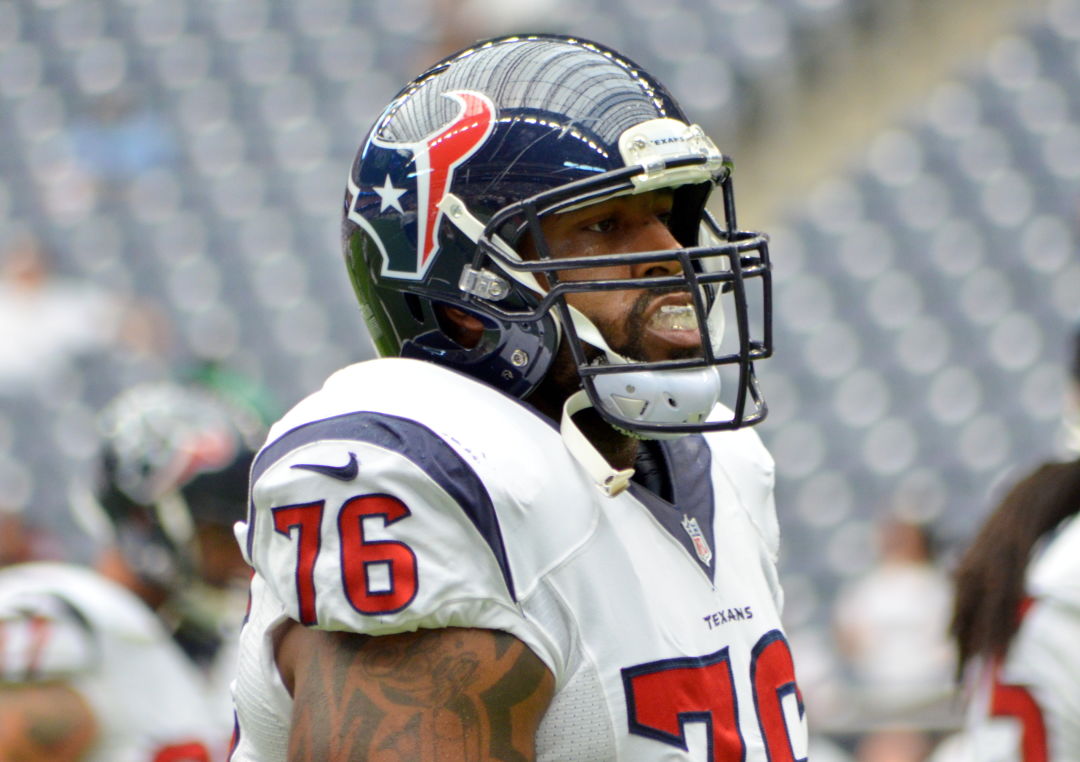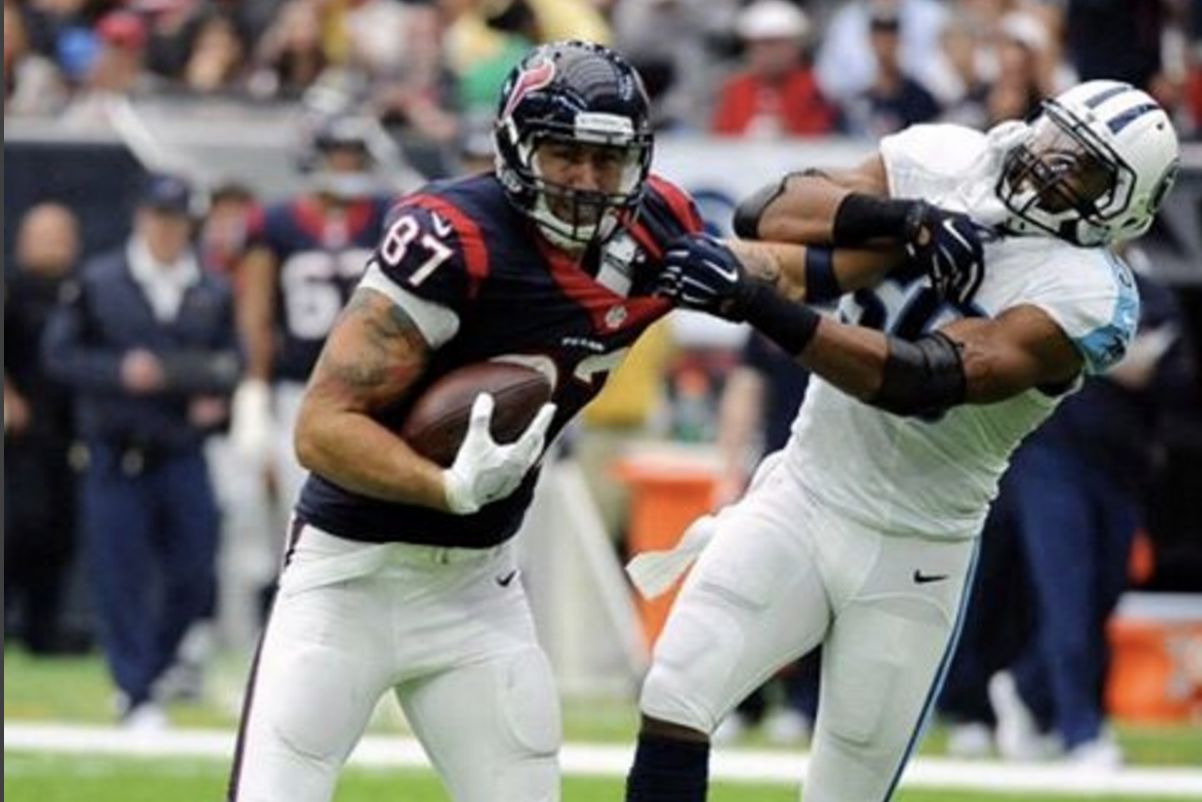The Texans Offseason Preview, Part Five: Offensive Line

Even Duane Brown, the one-time All-Pro and longtime rock of the offensive line, missed four games this year.
Image: Flickr/The Brit2
Having looked at all the skill players so far, we wrap up the offensive side of the ball by examining the Texans’ offensive line.
Current Roster
- LT Duane Brown, 32, signed through 2018, $9,650,000 cap hit
- LG Xavier Su’a-Filo, 26, signed through 2017, $1,766,418 cap hit
- C Nick Martin, 24, signed through 2019, $1,085,221 cap hit
- RG Jeff Allen, 27, signed through 2019, $6,437,500 cap hit
- RT Derek Newton, 29, signed through 2019, $5,500,000 cap hit
- T Chris Clark, 31, signed through 2017, $3,250,000 cap hit
- T Kendall Lamm, 25, signed through 2017, $615,669 cap hit
- T Laurence Gibson, 26, signed through 2018, $465,000 cap hit
- G Josh Walker, 26, signed through 2017, $615,000 cap hit
- G Chad Slade, 25, signed through 2018, $465,000 cap hit
- C Greg Mancz, 25, signed through 2017, $617,000 cap hit
- C Tony Bergstrom, 31, signed through 2017, $3,250,000 cap hit
Free Agents
- G Oday Aboushi, 26, Unrestricted Free Agent, 2016 cap hit: $675,000
- T David Quessenberry, 27, Unrestricted Free Agent, 2016 cap hit: $361,363*
* not on active roster; did not count against salary cap
The biggest obstacle to the line’s performance last season was health. Nick Martin was drafted in the second round to be the starting center, but missed the entire season with an ankle injury. Right tackle Derek Newton only suited up for six games. Even Duane Brown, the one-time All-Pro and longtime rock of the offensive line, missed four games this year. It can be difficult to evaluate a unit that depends on coherency, when so many of its members missed time and that coherency was difficult to develop.
Pro Football Focus’ grading system was not kind to the Texans; though the line graded out 18th among the 32 teams this year, that was primarily the work of two people: the stalwart Brown, and Greg Mancz, Martin’s replacement at center. Chris Clark played most of the snaps at right tackle and was one of the worst players in the league at the position. Clark, at least, was a fill-in who wasn’t projected to play as much as he was.
On the other hand, the guards graded out poorly as well, and they represent serious investments by the team. Right guard Jeff Allen was the third of the Texans’ major free-agent signings last offseason, with a deal that averages $7 million a season. Left guard Xavier Su’a-Filo was the 33rd overall pick in the 2014 draft, still a sore spot for some fans who watched Derek Carr go to the Raiders three picks later and solve their quarterback problem. (Even Joel Bitonio, taken 35th by Cleveland, has outplayed Su’a-Filo at the same position.)
I don’t think the team will try very hard to retain its free agents. Oday Aboushi came over from the Jets after being released by the Texans; he filled in at guard when Allen or Su’a-Filo missed time, but probably isn’t a long-term answer. It’s possible they try to bring him back cheaply as the backup guard (most teams only carry eight or even seven offensive linemen on the active roster).
David Quessenberry was a member of the Texans’ famously unproductive (outside of DeAndre Hopkins) 2013 class; however, as most fans of the team know, his inability to get onto the field was not a performance issue but a 2014 diagnosis of lymphoma. The team put him on the “non-football injury/illness” list in 2016. It’s unclear if Quessenberry will ever be able to play in the NFL again; I’m sure the Texans would love to give him a chance, but I’m equally sure they’re not in the business of paying players who can’t play, even if the reason they can’t play is no fault of their own.
Beyond the five starters, Mancz is the only one whose performance was good enough to make him a lock for the roster next year. Clark and Aboushi rounded out the active offensive linemen, but at their level of play I wouldn’t be surprised if the Texans decided to look elsewhere to fill those roster spots. Tony Bergstrom was signed before the team drafted Martin, and then Mancz passed him on the depth chart.
He’s a strong candidate to be released, since $3.25 million is too much to pay for a third-string center (and it’s highly unlikely they’d ever carry a third center on the active roster). Releasing Bergstrom and Clark would leave the team with $875,000 in dead money, but that’s down from the $6.5 million in cap space it would cost to pay both players to sit on the bench.
The big question for next year, then, is whether the team will bring in some competition for some of the weaker spots on the line. Long-term, some changes will certainly be forthcoming: Brown will decline eventually (hopefully not before his contract expires), and if Newton begins an age-based decline and/or can’t stay healthy, he may end up being released before his contract is up. Given Su’a-Filo’s performance, the team might let him walk when his rookie contract expires in a year. (Indeed, I wouldn’t be all that surprised if the team decided to start Mancz at center and move Martin to Su’a-Filo’s left guard spot.)
The Texans’ most likely move this offseason, then, or at least the most sound move in my view, would be to add someone who can push Su’a-Filo and Newton in 2017 and possibly take over for one of them in 2018. I would expect the team to draft a lineman in one of the first three rounds as the best way of addressing this, getting someone on a cheap contract whom the team can develop to be a starter in 2018 and beyond. Cam Robinson of Alabama is the draft’s top-rated offensive tackle, though he might not be there at pick 25. Wisconsin’s Ryan Ramczyk and Utah’s Garett Bolles are also highly rated in certain scouting circles, but I have questions about both. (With Ramczyk, it’s a shoulder injury; with Bolles, it’s age — he’ll already be 25 when his rookie season starts.) If the team wants a long-term left tackle replacement for Brown, the best options beyond those top three are probably Florida State's Roderick Johnson or Troy's Antonio Garcia.
On day two, Pat Elflein of Ohio State or Dorian Johnson of Pittsburgh might be options at guard. If they want someone who could play guard or tackle, Western Michigan’s Taylor Moton is one of my favorite underrated prospects this draft. While watching tape of Western Michigan receiver Corey Davis, widely regarded as a first-round pick, I kept noticing that the right tackle was blowing players off the ball consistently. When I discovered Moton had that kind of agility while weighing in in the 320-330 pound range, I got even more excited. He wasn’t as dominant in Western Michigan’s bowl game against Wisconsin, the team’s first truly difficult matchup all year, but he played well enough that I’d still happily take him with the Texans’ second-round selection and call it a steal.
All in all, the major issue with the offensive line is getting everyone healthy and playing together. The team does need to start making contingencies, though; those players might not be able to stay healthy, or they might not be good enough even when they are healthy, especially if they age into a decline in performance. It would be smart for the team to draft at least one lineman as part of the long-term rebuilding of the line, and finding a value free agent to compete at some of the weaker spots is probably a good idea as well.
Ages are as of the 2017 season kickoff on September 7. Cap numbers are taken from spotrac.com.




